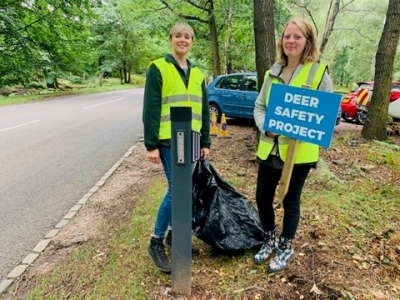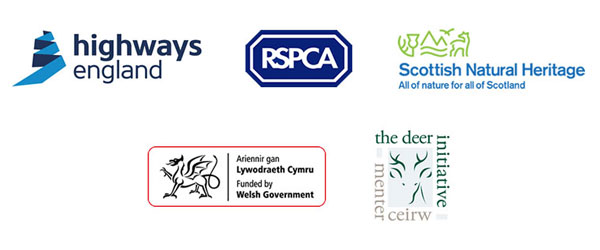
Cannock Chase Deer Safety Project
 28/09/21
28/09/21The Cannock Chase Deer Safety Project was set up 3 years ago to trial new technologies and methods used around the world to help prevent deer vehicle collisions.
It is run by Robert Taylor from the Staffordshire County Ranger Service and a core volunteer team (Zoe Campwell, Nathan Cooper, and Emily Mcardle) plus another 6 volunteers.
The project has been gathering data from trail cams and past DVC figures to assess each mitigation method, looking at animal behaviours, reactions etc. By collating the data, it is possible to identify the best methods and trial these across black spots within the road network of Staffordshire.
The current trial is focusing on fallow deer, which are a medium to large sized deer in the UK. Fully grown males (bucks) stand at around 0.84 to 0.94m tall at the shoulder and weigh between 46 to 93kg. Fully grown females (does) are 0.73 to 0.91m at the shoulder and weigh between 35 to 56kg.
Methods Being Trialled
The project is testing multiple methods from across the world. This is because the issue requires more than a ‘one size fits all’ approach. In the UK alone there are six different species of deer living wild, each of a different size and often with different behaviours when it comes to roads.
Current trials as part of the project include:
- Deer Deter DD430/40 Virtual Road Fence (Austria)
LED blue & orange flashing lights and two alarm sounds set off by vehicle headlights. - Gamewarner Version 3 (day & night) Transmitter (Germany)
LED blue & orange flashing lights with a variable alarm on each device. These work during day & night-time hours, set off by vehicle road noise. These devices also connect to each other and have periods of intermittent sounds, so deer find it harder to get use to them.
Sadly, in May of this year, some of the Gamewarner transmitters were vandalised and at the time Robert highlighted the project would benefit from a supply of replacement and spare transmitters. Transmitters are not easily replaced as they need to be ordered from Germany at a cost of around £150 each. - Multiwarn Reflectors (Germany)
Theses units use multiple highly reflective and varied individual-coloured lenses to make up a whole reflector, with each reflector having a different formation, causing vehicle headlights to reflect colours into the road verge. - Swalo-Flash Reflectors (Germany)
A highly reflective unit, as a vehicle headlight bounces off the reflector, the light causes a strobe effect into the road verge, so it appears to the deer that the car is coming straight for it. - Scented Fence (Germany)
This is a system that can be used anywhere without too much infrastructure and in hard-to-reach places.
It works as a form of repellent using a highly scented type of expanding foam at 5-meter intervals in a triangle formation. Once the foam is set, a further repellent is injected into the foam which can last up to 6 months. - PIR Strobe/ Alarm Deterrent (USA)
This animal deterrent device is set off by the animal itself, so it is more of a preventative initiative than just allowing deer to cross a road when it is quiet. The device can activated from up to 6/7 meters away and has multiple settings with a loud alarm and red-light strobe. - PIR MP3 Unit (Africa)
The original technique used in Africa to prevent elephants from accessing plantations using bees. The sound of humming beehives was enough to keep elephants from crossing over a boundary. Trials on Cannock Chase for the fallow deer have been very promising, as the mp3 unit can play up to 6 different sound effects (bees, car vehicles, woodland walk sounds, complete with sticks breaking and people talking). This is also classed as a preventative technique to completely stop deer from crossing a road even when there is no traffic. - White Bags (USA)
Originally an accidental form of deterrent when covering red reflectors in the state of Wyoming (USA) using black/ hessian bags. When they ran out, white bags were used as a backup and during the time the reflectors were covered, it was discovered that there were less in the white bag areas than with the reflectors uncovered or black/hessian bags.
The rationale is that the white tail deer seeing the white bags as a potential risk up ahead, warn other deer by showing/lifting their tails.
In addition to the trials, the Cannock Chase Ranger Service and deer safety project are currently installing temporary deer warning signs across the Chase and potential blackspots across Staffordshire for the upcoming rut and winter period, when there is often a rise in deer vehicle collisions.
Preventing Red Deer on the M6 Toll Road
Beyond Cannock Chase the project team have been consulting and advising with the M6 Toll (Midland Expressway) to help prevent red deer from accessing the slip roads on to the motorway. After a site visit and looking at different methods from the Cannock Chase project, the PIR strobe/alarm deterrent and PIR mp3 sensor have proven to work well. Deer completely avoid the area after the sensors have been triggered. Results are looking promising with a 90% success rate to date. The team are also working to set up a scented fence on the M6 Toll Road after some encouraging data.
Funding and How You Can Help
So far the project has received funding from Staffordshire Commissioner Police Fund; Hanson Aggregates; Cemex Quarry; Cannock Chase AONB and volunteer cake & marathon sales/sponsorship, plus various other initiatives and organisations.
It would be beneficial if more organisations supported the Cannock Chase Deer Safety Project and its valuable research into preventing deer vehicle collisions. If you would like to support the project, please contact Robert Taylor at [email protected]





